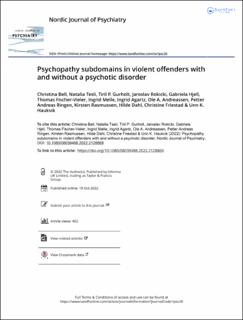| dc.contributor.author | Bell, Christina | |
| dc.contributor.author | Tesli, Natalia | |
| dc.contributor.author | Gurholt, Tiril Pedersen | |
| dc.contributor.author | Rokicki, Jaroslav | |
| dc.contributor.author | Hjell, Gabriela | |
| dc.contributor.author | Fischer-Vieler, Thomas | |
| dc.contributor.author | Melle, Ingrid | |
| dc.contributor.author | Agartz, Ingrid | |
| dc.contributor.author | Andreassen, Ole | |
| dc.contributor.author | Ringen, Petter Andreas | |
| dc.contributor.author | Rasmussen, Kirsten | |
| dc.contributor.author | Dahl, Hilde | |
| dc.contributor.author | Friestad, Christine | |
| dc.contributor.author | Haukvik, Unn Kristin Hansen | |
| dc.date.accessioned | 2022-12-06T08:07:01Z | |
| dc.date.available | 2022-12-06T08:07:01Z | |
| dc.date.created | 2022-11-04T14:31:34Z | |
| dc.date.issued | 2022 | |
| dc.identifier.citation | Nordic Journal of Psychiatry. 2022, . | en_US |
| dc.identifier.issn | 0803-9488 | |
| dc.identifier.uri | https://hdl.handle.net/11250/3035972 | |
| dc.description.abstract | Background
Violence in psychosis has been linked to antisocial behavior and psychopathy traits. Psychopathy comprises aspects of interpersonal, affective, lifestyle, and antisocial traits which may be differently involved in violent offending by persons with psychotic disorders. We explored psychopathy subdomains among violent offenders with and without a psychotic disorder.
Methods
46 males, with a history of severe violence, with (n = 26; age 35.85 ± 10.34 years) or without (n = 20; age 39.10 ± 11.63 years) a diagnosis of a psychotic disorder, were assessed with the Psychopathy Checklist-Revised (PCL-R). PCL-R was split into subdomains following the four-facet model. Group differences in total and subdomain scores were analyzed with a general linear model with covariates.
Results
Total PCL-R scores did not differ between the groups (p = 0.61, Cohen’s d = 0.17). The violent offenders without psychotic disorders had higher facet 2 scores than the patient group with psychotic disorders (p = 0.029, Cohen’s d = 0.77). Facet 1, 3, or 4 scores did not differ between the groups. Controlling for age did not alter the results.
Conclusion
Patients with a psychotic disorder and a history of severe violence have lower affective psychopathy scores than violent offenders without psychotic disorders. This observation may point toward distinct underlying mechanisms for violence and may provide a target for focused treatment and prevention. | en_US |
| dc.language.iso | eng | en_US |
| dc.publisher | Taylor and Francis Group | en_US |
| dc.rights | Navngivelse 4.0 Internasjonal | * |
| dc.rights.uri | http://creativecommons.org/licenses/by/4.0/deed.no | * |
| dc.title | Psychopathy subdomains in violent offenders with and without a psychotic disorder | en_US |
| dc.title.alternative | Psychopathy subdomains in violent offenders with and without a psychotic disorder | en_US |
| dc.type | Peer reviewed | en_US |
| dc.type | Journal article | en_US |
| dc.description.version | publishedVersion | en_US |
| dc.source.pagenumber | 0 | en_US |
| dc.source.journal | Nordic Journal of Psychiatry | en_US |
| dc.identifier.doi | 10.1080/08039488.2022.2128869 | |
| dc.identifier.cristin | 2069321 | |
| cristin.ispublished | true | |
| cristin.fulltext | original | |
| cristin.qualitycode | 1 | |

